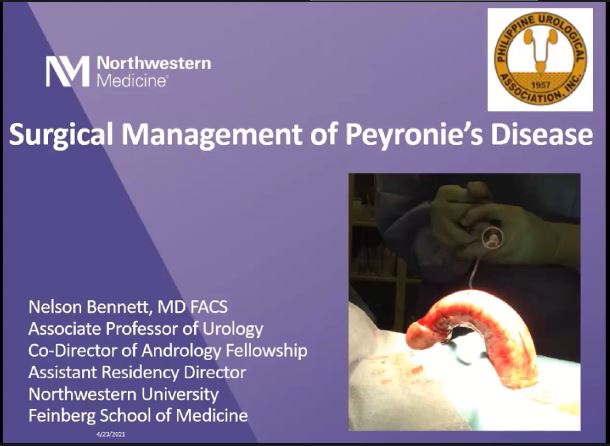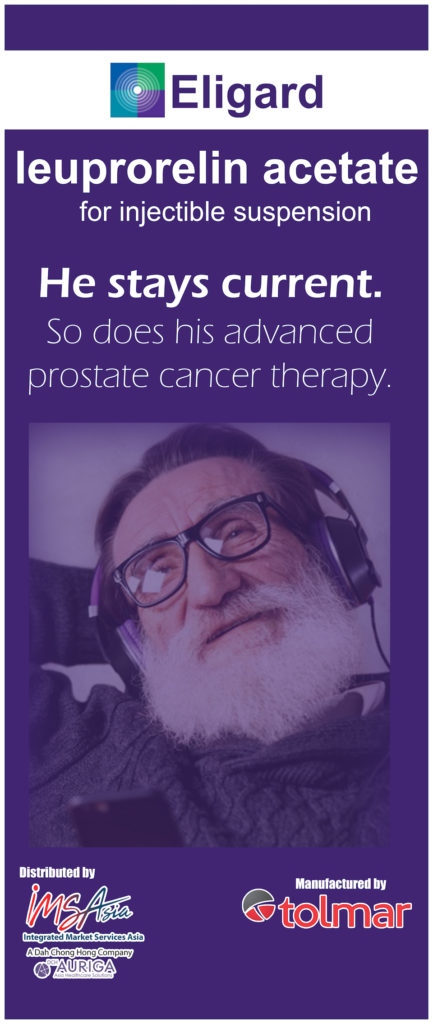The 1st session of day 1 of this year’s mid-year convention conducted through a virtual congress tackled about Erectile dysfunction. The second topic is entitled, Surgical Management of Peyronie’s Disease (PD). Dr. Bennett began by describing its history, with its name derived from Francois de la Peyronie, and its standard definition of abnormal collagen depositions/ scarring of the tunica albuginea of the corpus cavernosum, characterized by excessive fibrosis and plaque formation. Its prevalence is estimated at 9 to 13% in adult men, with the average age of 53 years. It comes in different shapes and sizes, for example hourglass curvature, and if uncorrected, may lead to the following sequelae: penile curvature, penile tapering, notching, erectile dysfunction, partner pain during intercourse, decreased self-esteem and depression.
He mentioned two distinct stages of the disease. The acute inflammatory stage which is mainly characterized by pain, present in either flaccid state or as painful erections, and the chronic/ fibrotic stage when the pain disappears and the deformity stabilizes. These phases are important since surgical treatment is reserved and indicated for those significant deformity or with inability to penetrative intercourse, desiring for rapid and reliable results. The aims of reconstruction is to address mainly the deformity (functionally straight at less than or equal to 15 to 30 degrees curvature), while preserving the penile length and erectile function allowing satisfactory sexual relations afterwards.
The choice of the surgical technique relies on the length of the penis, severity of deformity, circumcision status, erectile function, patients’ expectations and surgeon’s preference. Dr. Bennett emphasized that artificial erection is mandatory to properly identify the correct procedure for each patient. He enumerated different tunica albuginea plication(TAP) techniques which makes the longer the side of the penis shorter. These techniques are as follows: Nesbit (excision and closure), Yachia (incision and closure), Lue (16-dot plication) and the Duckett/ Baskin TAP (partial incision and plication). These techniques were discussed in detail in a video presentation. These procedures are relatively simple, minimally invasive and preserves potency, however its disadvantages include possibility of penile shortening and may worsen its narrowing. These techniques are best suited for unidimensional curves. A study on its outcomes illustrated a graph showing that there is a direct relationship between the mean penile length lost with the degree of curvature, meaning that with the curvature as high 65 degrees and above can have a mean length loss of up to 4%. Furthermore, he also elaborated on the grafting techniques done after plaque removal. He listed the characteristics of an ideal graft, as follows: pliable, compliant, with sutured, high tensile strength, low antigenicity, minimal inflammatory response, low infection transmission risk, low-cost, and can be easily handled/sutured. The types of grafting materials he mentioned were grouped into synthetic, autologous and extracellular matrix. The best grafts according to him are autologous grafts which varies with the following: dermis, fascia lata, tunica vaginalis, crural tunica albuginea, vein, buccal mucosa. The extracellular matrix such as pericardium, small intestinal submucosa of porcine jejunum, or collagen fleece are termed “off the shell” as it is rarely used since it is highly processed but are rarely available. Each autologous is easily harvested even with amount of tissue obtained, has excellent tensile strength and found to exhibit vascular ingrowth and endothelialization weeks after insertion, Tunica vaginalis, on the other hand, becomes albuginea in 6 months and is believed to have 88% success rate.
As he mentioned, part of the technique is the elevation and preservation of the neurovascular bundles which can be done on both the dorsal and ventral side. Tunical incision describe as H-incision may as well be modified to better accommodate for graft placement. Towards the end, he enumerated the usual course of his patients and the advises that he gives to them, It is usually ideal in a small suction drain at day 1 post op. They were as follows: removal of Foley catheter and suction at day 1 post op, Penile stretching and low-dose PDE-5 inhibitor is valuable in the management and Peyronie’s disease. In the end of his lecture, he emphasized the ISSM Standards Committee recommendations which summed up everything that he has discussed.

Dr. Nelson E. Bennett
Dr. Nelson E. Bennett is a board-certified urologist and microsurgeon who specializes in the management of erectile dysfunction, Peyronie’s disease, disorders of ejaculation and orgasm, vasectomy, penile prosthesis implantation, and microsurgical varicocele repair. He is a graduate of the University of Pittsburgh School of Medicine and completed residency in Urologic Surgery at the University of Pittsburgh Medical Center followed by a two-year fellowship at Memorial Sloan-Kettering Cancer Center in Sexual Medicine and Surgery. Dr. Bennett is the Co-Director of the Andrology Fellowship. He is actively involved as a leader in numerous national and international organizations, including the Sexual Medicine Society of North America (SMSNA), the International Society for Sexual Medicine (ISSM), the American Urologic Association (AUA), and the National Medical Association (NMA).

Marvin D. Castillo, MD
Resident, St. Luke’s Institute of Urology




0 Comments